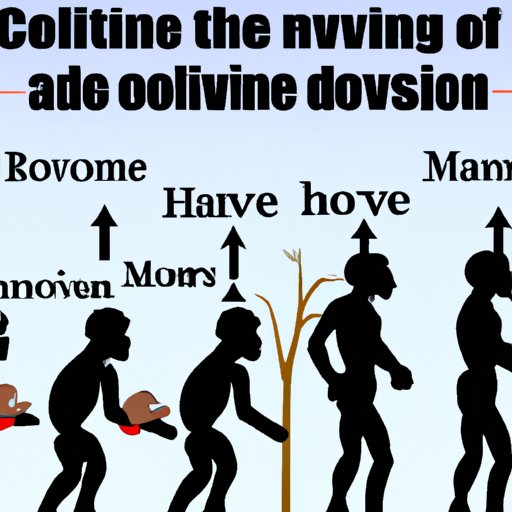Introduction
Evolutionary theory is the scientific study of how life has changed over time, from its earliest beginnings to the present day. This theory explains the origins of humanity, as well as the diversity of species on earth. The study of human evolution seeks to understand how our ancestors have adapted to their environment and evolved into the species we are today.
In this article, we will explore the evolutionary theory, timeline of human evolution, and anthropological perspective on how humans came to be. We will examine the role of natural selection, climate change, and genetics in the development of modern humans.
Evolutionary Theory: Exploring the Origins of Humanity
The theory of natural selection is one of the primary theories used to explain the origins of humanity. This theory states that organisms with advantageous traits are more likely to survive and reproduce, thus passing on those traits to their offspring. Over time, these beneficial traits become more common in a population, resulting in evolutionary change. In other words, natural selection is a gradual process by which certain characteristics become more prominent in a species.
The fossil record also provides insight into the evolution of humans. Fossils are the preserved remains or traces of ancient organisms, and they can provide evidence about the physical features and behavior of our ancestors. By studying these fossils, scientists are able to piece together details about our evolutionary history.

Timeline of Human Evolution: From Primates to Modern Humans
The timeline of human evolution begins with early hominid species, such as Australopithecus. These species were bipedal primates that lived in Africa between 4 and 2 million years ago. They had brains that were slightly larger than those of chimpanzees, but much smaller than those of modern humans.
Homo sapiens sapiens, the species to which all modern humans belong, appeared around 200,000 years ago. These Homo sapiens sapiens had larger brains than earlier hominids, and they developed language and culture. They were also capable of making tools and weapons, which allowed them to hunt animals for food and protect themselves from predators.

The Origin of Humans: An Anthropological Perspective
Anthropologists believe that humans first evolved in Africa, and then spread across the globe through migration. Early humans moved out of Africa in waves, settling in different regions and adapting to the local environment. As they migrated, they encountered new challenges and opportunities, which led to further adaptations.
These migrations were driven by climate change, as well as competition for resources. For example, when the climate became cooler and drier in some regions, humans moved to areas with more favorable conditions. Similarly, when resources became scarce in one area, humans looked for new sources of food and shelter elsewhere.
Migration and Adaptation: How Did Humans Populate the Globe?
Climate change has played an important role in human evolution. As the climate shifted from warmer to cooler temperatures, populations moved to new areas that had more suitable conditions. For example, during the last Ice Age, humans migrated to Europe and Asia in search of more hospitable climates.
Human migration routes have also been shaped by geography. Mountain ranges, deserts, and other physical barriers have limited movement in certain directions. As a result, human populations have adapted to local environments and developed unique cultures.

The Role of Genetics in Human Evolution
Genetics is another key factor in human evolution. DNA analysis has revealed that all humans share common ancestors and that our genetic makeup is constantly changing. Certain traits, such as skin color and eye shape, are inherited from our parents, while others, like height and intelligence, are determined by a combination of genes and environmental factors.
In addition, genetic mutations can lead to new traits that can be passed down to future generations. These mutations can occur randomly, or they can be triggered by environmental factors, such as changes in diet or exposure to radiation.
Conclusion
The evolutionary theory, fossil record, and genetic evidence all point to the same conclusion: humans evolved from primates over millions of years. Migration and adaptation have played major roles in the development of modern humans, who now inhabit every continent on earth. The study of human evolution is an ongoing process, and as new discoveries are made, our understanding of how we came to be continues to evolve.
(Note: Is this article not meeting your expectations? Do you have knowledge or insights to share? Unlock new opportunities and expand your reach by joining our authors team. Click Registration to join us and share your expertise with our readers.)
